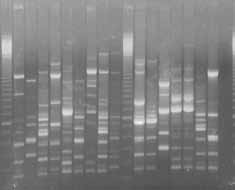The organic nitrogen found in the complex structures of collagen may be available to absorption by plants as a result of natural processes of organic matter mineralization. In these biochemical processes, such as matter decomposition, biogeochemical cycles and organic matter transformation, a key role is played by soil microorganisms.

For certain and in-depth information on how AGROGEL® affects soil bacterial populations, applied microbiology
studies have been initiated.
This type of innovative study has two main areas:
1. QUANTITATIVE ANALYSIS OF BACTERIAL COMMUNITIES WITH ENUMERATION OF CULTURABLE COLONIES

Photo: Colonies on Petri dish.
IThis makes it possible to calculate the total amount of living cells, and then have a general information on the consistency of the microbial communities in the soil system. The effects of stimulating the development of the colonies were monitored at 30, 60 and 90 days after incubation, in order to evaluate a long period of microbial life.
2. MOLECULAR QUANTITATIVE ANALYSIS OF BACTERIAL COMMUNITIES WITH GENES AMPLIFICATION BY 16S RIBOSOMAL RNA AND COMPARISON OF ELECTROPHORETIC PATTERNS WITH COMPUTERASSISTED IMAGE ANALYSIS AND STATISTICAL CLUSTER ANALYSIS

Photo: Electrophoretic gel of microbial communities at time 1.
This type of analysis is very complex and goes from rough soil up to the direct study of genes. The total DNA content in soil microbial cells is extracted according to a precise protocol, and then amplified by PCR (Polymerase Chain Reaction). Profiles can be build from the results, whose preparation results in the fingerprinting of the microbial community, which is then treated with cluster analysis.
This type of reconstruction allows highlighting which fertilizers induce the major qualitative similarities in microbial communities, and consequently those fertilizers that have the most similar effects to each other on soil microorganisms, whose mineralization they themselves trigger.
The first evaluation on culturable cells in a soil with AGROGEL® showed a significant development of microbial populations, up to obtaining a population that fluctuated around 100 million cultivable cells per g of dry soil. This indicated then that the soil microflora responded well to nitrogen and carbon stimuli
Chart: Result of the applied microbiology study on bacterial populations
conducted in the laboratory of Prof. Squartini from the University of Padua.

Continuing with the analysis, the true mineralizers of nitrogen were sought in detail (via PCR).
Chart: Continuing with the analysis, the true mineralizers of nitrogen were sought in detail (via PCR)
Result of the study of applied microbiology on the nitrifying bacteria populations conducted in the laboratory of Prof. Squartini from the University of Padua, with respect to AGROGEL®.

It is evident that after 30 days of incubation, the soil to which AGROGEL® has been applied shows an extremely higher number of nitrifying bacteria (bacteria key to the oxidative processes of nitrogen matrices) compared to untreated soil. After 90 days of incubation, it can be seen that the number of cells in the control soil is reduced, while the product AGROGEL® continues to support nitrifiers.
The results therefore indicate that soil microorganisms are supported in their growth by the use of AGROGEL®, which becomes the main source of aminoacids to build the proteins necessary for cell growth. In fact, even though the main nitrogen reserve is the atmosphere, most living organisms are not able to use elementary nitrogen to produce aminoacids and other nitrogen compounds. Also, nitrogen availability in the soil is often one of the factors limiting the growth of bacterial populations and plants.
